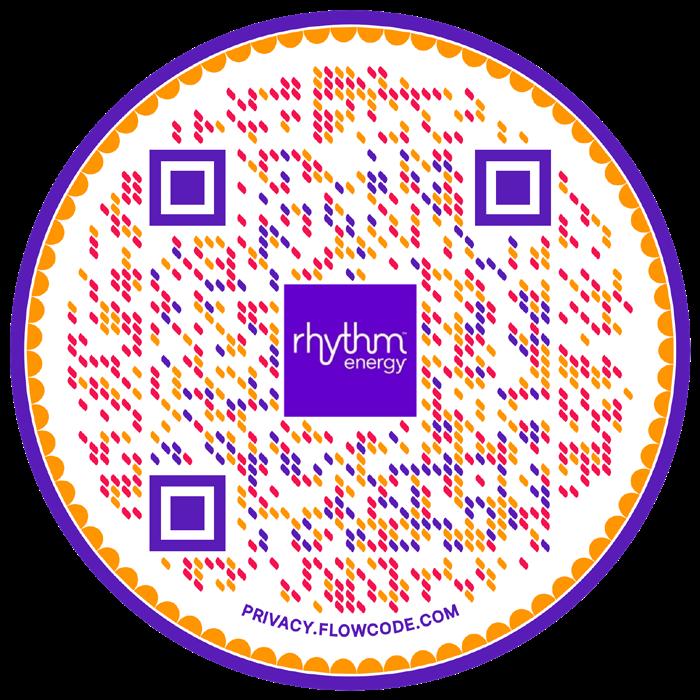A comprehensive guide to understanding your 2026 Rhythm Energy employee benefits


A comprehensive guide to understanding your 2026 Rhythm Energy employee benefits

We are pleased to offer a full benefits package to you and your eligible dependents. Read this guide to know what benefits are available to you. You may only enroll for or make changes to your benefits during Open Enrollment or when you have a Qualifying Life Event.
Your plan offers three health coverage options. To help you make an informed choice and compare your options, a Summary of Benefits and Coverage (SBC) for each plan option is available at www.cigna.com or by contacting Human Resources.

If you (and/or your dependents) have Medicare or will become eligible for Medicare in the next 12 months, federal law gives you more choices for your prescription drug coverage. Please see page 26 for more details.


You are eligible for coverage if you are a regular, full-time employee. You may only enroll for coverage when:
● You are a new hire
● It is Open Enrollment (OE)
• Regular, full-time employee
Eligibility
Enrollment
Coverage Begins
working an average of 30 hours per week
• Enroll during Open Enrollment or when you have a Qualifying Life Event
• Open Enrollment: Start of the plan year
• Qualifying Life Event: Ask Human Resources
• Regular, full-time employee working an average of 30 hours per week
• Enroll by the deadline given by Human Resources
• Your date of hire
● You have a Qualifying Life Event (QLE)
• Your legal spouse or domestic partner
• Child(ren) under age 26 regardless of student, dependency, or marital status
• Child(ren) over age 26 who are fully dependent on you for support due to a mental or physical disability and who are indicated as such on your federal tax return
• You must enroll the dependent(s) at Open Enrollment or for a Qualifying Life Event
When covering dependents, you must enroll for and be on the same plans
• Based on 2026 effective dates
CHANGING COVERAGE OUTSIDE OF OPEN ENROLLMENT
You may only change coverage during the plan year if you have a Qualifying Life Event, such as:




Gain or loss of benefits
Change in employment status affecting
Significant change in cost of spouse’s

You have 60 days from the event to log in at
documents
1. Review this employee benefits guide and decide which benefits you prefer.
2. Log in at www.rippling.com or download the Rippling app
3. Select My Benefits.
4. Select Upcoming benefits if you are enrolling for the plan year. Select Current benefits if you are changing your benefits because of a qualified life event.
5. Choose to enroll or decline. If you decline, elect that you are waiving the option to enroll. Rippling will ask you to indicate the reason for declining coverage for each benefit.

Contact your Human Resources department or the Employee Response Center at 866-419-3518 .

The medical plan options through Cigna protect you and your family from major financial hardship in the event of illness or injury. You have a choice of three plans:
This HDHP plan has a $5,000 Individual and a $10,000 Family in-network deductible.
This PPO plan has a $3,000 Individual and a $6,000 Family in-network deductible.
A High Deductible Health Plan (HDHP) allows you to see any provider when you need care, and you will pay less for care when you go to in-network providers. In exchange for a lower per-paycheck cost for medical benefits, you must satisfy a higher plan deductible that applies to almost all health care expenses, including prescription drugs. If you enroll in the HDHP, you may be eligible to open a Health Savings Account (HSA) (see page 15).
3
This PPO plan has a $500 Individual and a $1,000 Family in-network deductible.
An Open Access Plan (OAP) makes it easy to get quality, in-network care through a large, national network of providers. Choosing a primary care provider to coordinate your care is an option, and you do not need a referral to see a specialist. When you see in-network providers, your office visits, urgent care visits, and prescription drugs are covered with a copay, and most other network services are covered at the coinsurance level.


•
•

¹ What you will pay after your
2 Copay waived if admitted.
3 Must use the Cigna Pathwell Specialty
2
•

Save money by referring to the list of covered medications at www.mycigna.com. Your cost is based on whether your medication is a generic, preferred brand, non-preferred brand, or specialty medication.
Know which medication your medical plan covers by referring to the Cigna Advantage 3-Tier drug list. Go to www.cigna.com/druglist to search. Use the price tool to see how much you will pay for covered drugs. You can also see specific requirements for drugs – such as quantity limits or prior authorization needed.
Pay less and eliminate the need for claim forms when you use in-network pharmacies for your prescriptions. Show your Cigna ID card to your pharmacist and pay the amount shown in the medical benefits summary chart. If you use an out-of-network pharmacy, you must pay in full when the prescription is filled and file a claim for reimbursement.
If you take medication on a regular basis for a chronic condition, Cigna 90 Now will make buying your maintenance medications easier. The program allows you to choose how, where, and in what quantity you fill your medication. You can:
● Choose a 30-day or 90-day supply
● Choose a pharmacy for retail or home delivery
● Order, manage, track, and pay for medications by phone or online
CVS, Walmart, Albertsons/Safeway, Publix, Weis Markets, and Winn Dixie are just some of the in-network pharmacies that can fill a 90-day prescription. Go to www.cigna.com/rx90network or download the myCigna app to learn more.

Cigna’s Express Scripts Home Delivery service is a convenient, cost-effective way to receive up to a 90day supply of prescription drugs. Your medication is delivered by mail directly to your home or work address. Orders can be managed online and through the myCigna app . To learn more about the Home Delivery Service, call 800-835-3784 or access www.cigna.com/homedelivery

The following programs and services are available to those enrolled in a Cigna medical plan at no additional cost. Access myCigna.com to access the following or to learn more.
myCigna serves as your one-stop-shop for all Cigna health plan and benefits information. Key features include managing and tracking claims, accessing digital ID cards, finding in-network providers, accessing cost comparison tools, reviewing coverage details, and more. Visit www.mycigna.com to register.
● Health Information Line – Speak to a nurse at any time to get answers and/or recommendations based on your specific health situation. Call the number on the back of your Cigna ID card for 24/7 access to the Health Information Line.
● One Guide – Get assistance from a personal guide who can help you navigate your Cigna benefits and resources. Call the number on the back of your Cigna ID card or speak to someone virtually via the click-to-chat function on www.mycigna.com or call 866-494-2111
● Live, 24/7 Customer Service support – Contact a representative via phone, chat, or app.
Download the myCigna mobile app to access your Cigna health plan and benefits information while on the go. This app helps you organize and access important plan information on your smartphone or tablet. It is also available in Spanish.
Preventive care is available at no additional cost to you. Get check-ups, biometric screenings, and wellness screenings in person or virtually.
In addition to behavioral and substance abuse providers, Cigna offers several programs and services for your emotional well-being. These include Talkspace, Ginger for Cigna, and digital tools, such as iPrevail and Happify.
Get virtual physical therapy from the comfort of your home with RecoveryOne for Cigna.
If you have a chronic or complex medical condition, Cigna will help coordinate your care and provide the support you need to reach your health goals, including online coaching.
This resource offers identity monitoring, restoration, and response services to help protect you from identity theft. IdentityForce is available at no additional cost as part of your Cigna medical plan for you and any child(ren) living in your home up to age 18. Family coverage for adults in your home is available for purchase. To enroll, visit https://cigna.identityforce.com/starthere or call 833-580-2523

Virtual care from MDLIVE is available if you are enrolled in our medical plan. It is a convenient way to obtain care if you are traveling, away from home, or are unable to see your regular doctor. Connect anytime day or night with a board-certified doctor via your mobile device or computer for free or about the same cost as a visit to your regular physician.
Skip the hassle, travel, and waiting room with virtual care! Visit www.mycigna.com so you can speak to a doctor in a few minutes or schedule a virtual appointment that is most convenient for you. Doctors will diagnose nonemergency medical issues and prescribe medication, if needed.
While telehealth does not replace your primary care physician, it is a convenient and cost-effective option when you need care and:
● Have a non-emergency issue and are considering an after-hours health care clinic, urgent care clinic, or emergency room for treatment
● Are on a business trip, vacation, or away from home
● Are unable to see your primary care physician
USE TELEHEALTH SERVICES FOR MINOR CONDITIONS SUCH AS:
● Sore throat
● Headache
● Stomachache
● Cold/Flu
● Mental health issues
● Allergies
● Fever
● Urinary tract infections
● Dermatology
● Primary care
● Urgent care
● Behavioral care
Do not use telehealth for serious or life-threatening emergencies.
Registration is Easy
Register with MDLIVE so you are ready to use this valuable service when and where you need it.
Visit www.mycigna.com Call 888-726-3171
Download the MyCigna app to your smartphone or mobile device


Becoming familiar with your options for medical care can save you time and money.
NON-EMERGENCY CARE
Access to care via phone, online video, or mobile app whether you are home, at work, or traveling; medications can be prescribed.
VIRTUAL VISITS/ TELEHEALTH
DOCTOR’S OFFICE
RETAIL CLINIC
24 hours a day, 7 days a week
Generally, the best place for routine preventive care; established relationship; able to treat based on medical history.
Office hours vary
Usually lower out-of-pocket cost than urgent care; when you can’t see your doctor; located in stores and pharmacies.
Hours vary based on store hours
• Allergies
• Cough/cold/flu
• Rash
• Stomachache
URGENT CARE
EMERGENCY CARE
When you need immediate attention; walk-in basis is usually accepted.
Generally includes evening, weekend and holiday hours
• Infections
• Sore and strep throat
• Vaccinations
• Minor injuries/sprains/strains
• Common infections
• Minor injuries
• Pregnancy tests
• Vaccinations
• Sprains and strains
• Minor broken bones
• Small cuts that may require stitches
• Minor burns and infections

HOSPITAL ER
Life-threatening or critical conditions; trauma treatment; multiple bills for doctor and facility.
24 hours a day, 7 days a week
Services do not include trauma care; can look similar to an urgent care center, but medical bills may be 10 times higher.
• Chest pain
• Difficulty breathing
• Severe bleeding
• Blurred or sudden loss of vision
• Major broken bones
• Most major injuries except trauma
• Severe pain
FREESTANDING ER
24 hours a day, 7 days a week
Note: Examples of symptoms are not inclusive of all health issues. Wait times described are only estimates. This information is not intended as medical advice. If you have questions, please call the phone number on the back of your medical ID card.
Our dental plans help you maintain good oral health through affordable options for preventive care, including regular checkups and other dental work. Coverage is provided through Sun Life, using the Sun Life dental PPO network.
Two levels of benefits are available with the DPPO plan: in-network and out-of-network. You may see any dental provider for care, but you will pay less and get the highest level of benefits with in-network providers. You could pay more if you use an out-of-network provider.
Preventive Care
Exams, cleanings, X-rays, fluoride treatments, sealants, space maintainers
Basic Restorative Fillings, extractions, periodontics, root canals, endodontics, oral
This dental plan offers the Lifetime of Smiles program. Benefits include brush biopsy for the early detection of oral cancer.


Our vision plan offers quality care to help preserve your health and eyesight. Regular exams can detect certain medical issues such as diabetes and high cholesterol, in addition to vision and eye problems. You may seek care from any vision provider, but the plan will pay the highest level of benefits when you see in-network providers. Coverage is provided through Sun Life using the VSP vision network.
•
•
•
Lenses in lieu of eyeglasses
• Fitting and Evaluation
• Elective
• Necessary


Visit www.eyeconic.com to virtually try on glasses and make your purchase. You must first link your benefits to see how your coverage will apply to the available options.
An HSA is a tax-exempt tool to supplement your retirement savings and to cover current and future health costs.
As a type of personal savings account that is always yours even if you change health plans or jobs, the money in your HSA (including interest and investment earnings) grows tax-free and spends tax-free if used to pay for current or future qualified medical expenses. There is no “use it or lose it” rule — you do not lose your money if you do not spend it in the calendar year — and there are no vesting requirements or forfeiture provisions. The account automatically rolls over year after year.
Use it Now
● Make annual HSA contributions
● Pay for eligible medical costs
● Keep HSA funds in cash
Let it Grow
● Make annual HSA contributions
● Pay for medical costs with other funds
● Invest HSA funds
You decide whether to use the money in your account to pay for qualified expenses or let it grow for future use. If you are age 55 or older, you may make a yearly catch-up contribution of up to $1,000 to your HSA. If you turn 55 anytime during the plan year, you are eligible to make the catch-up contribution for the entire plan year.
Tax Benefits
HSA contributions are tax-deductible.
HSA contributions grow tax-deferred.
Withdrawals for qualifying medical expenses are tax-free.


You are eligible to open and contribute to an HSA if you are:
• Enrolled in an HSA-eligible HDHP – the OAP HDHP/HSA plan
• Not covered by another plan that is not a qualified HDHP, such as your spouse’s health plan
• Not enrolled in a Health Care Flexible Spending Account
• Not eligible to be claimed as a dependent on someone else’s tax return
• Not enrolled in Medicare, Medicaid, or TRICARE
• Not receiving Veterans Administration benefits
If you meet the eligibility requirements, you may open an HSA administered by Rippling . You will receive a debit card to manage your HSA account reimbursements. Keep in mind, available funds are limited to the balance in your HSA. To open an account, go to www.rippling.com

• Always ask your network doctor to file claims with your medical, dental, or vision carrier so you will get the highest level of benefits. You can pay the doctor with your HSA debit card for any balance due.
• You, not your employer, are responsible for maintaining ALL records and receipts for HSA reimbursements in the event of an IRS audit.

• You may open an HSA at the financial institution of your choice, but only accounts opened through Rippling are eligible for automatic payroll deduction and company contributions.
A Flexible Spending Account (FSA) allows you to set aside pretax dollars from each paycheck to pay for certain IRS-approved health and dependent care expenses. We offer three different FSAs: two for health care expenses and one for dependent care expenses. Rippling administers our FSAs.
The Health Care FSA covers qualified medical, dental, and vision expenses for you or your eligible dependents. You may contribute up to $3,400 annually to a Health Care FSA, and you are entitled to the full election from day one of your plan year. Eligible expenses include:
● Dental and vision expenses
● Medical deductibles and coinsurance
● Prescription copays
● Hearing aids and batteries
You may not contribute to a Health Care FSA if you enrolled in an HDHP and contribute to an HSA.
A Limited Purpose Health Care FSA is available if you enrolled in the HDHP medical plan and contribute to an HSA. You can use a Limited Purpose Health Care FSA to pay for eligible out-of-pocket dental and vision expenses only, such as:
● Dental and orthodontia care (e.g., fillings, X-rays, and braces)
● Vision care (e.g., eyeglasses, contact lenses, and LASIK surgery)

You can access the funds in your Health Care or Limited Purpose Health Care FSA two different ways:
● Use your Rippling FSA debit card to pay for qualified expenses, doctor visits, and prescription copays.
● Pay out-of-pocket and submit your receipts for reimbursement:
1. Go to www.rippling.com or download and use the Rippling app
2. Open the Rippling My Benefits app > Overview tab > under Current benefits
3. Click Go to dashboard, to the right of your FSA.
4. Under the Claims tab, click Submit New Claim, then follow the steps to complete the claim.

The Dependent Care FSA helps pay for expenses associated with caring for elder or child dependents so you or your spouse can work or attend school full-time. You can use the account to pay for daycare or babysitter expenses for your children under age 13 and qualifying older dependents, such as dependent parents. Reimbursement from your Dependent Care FSA is limited to the total amount deposited in your account at that time. To be eligible, you (and your spouse, if married) must be gainfully employed, looking for work, a full-time student, or incapable of self-care.
● Overnight camps are not eligible for reimbursement (only day camps can be considered).
● If your child turns age 13 midyear, you may only be reimbursed for the time the child was under age 13.
● You may request reimbursement for care of a spouse or dependent of any age who spends at least eight hours a day in your home and is mentally or physically incapable of self-care.
● The dependent care provider cannot be your child under age 19 or anyone claimed as a dependent on your income taxes.
● The maximum per plan year you can contribute to a Health Care or Limited Purpose Health Care FSA is $3,400 The maximum per plan year you can contribute to a Dependent Care FSA is $7,500 when filing jointly or head of household and $3,750 when married filing separately.
● You cannot change your election during the year unless you experience a Qualifying Life Event.
● For Dependent FSA, claims for expenses incurred during the plan year must be submitted by March 31, 2026 for reimbursement.
● Your Health Care or Limited Purpose Health Care FSA debit card can be used for health care expenses only. It cannot be used to pay for dependent care expenses.
● The IRS has amended the use it or lose it rule to allow you to carry over up to $680 in your Health Care FSA into the next plan year. The carryover rule does not apply to your Dependent Care FSA.

care expenses (such as daycare, after-school programs, or eldercare programs) so you and your spouse can work or attend school full-time
$7,500 (filing jointly or head of household); $3,750 (married and filing separate tax returns)
The products and services listed below are examples of medical expenses eligible for payment under your Health Care FSA or HSA. This list is not all-inclusive; additional expenses may qualify, and the items listed are subject to change in accordance with IRS regulations. Please refer to IRS Publication 502 Medical and Dental Expenses at www.irs.gov for a complete description of eligible medical and dental expenses.
● Abdominal supports
● Acupuncture
● Air conditioner (when necessary for relief from difficulty in breathing)
● Alcoholism treatment
● Ambulance
● Anesthetist
● Arch supports
● Artificial limbs
● Autoette (when used for relief of sickness/disability)
● Blood tests
● Blood transfusions
● Braces
● Cardiographs
● Chiropractor
● Contact lenses
● Convalescent home (for medical treatment only)
● Crutches
● Dental treatment
● Dental X-rays
● Dentures
● Dermatologist
● Diagnostic fees
● Diathermy
● Drug addiction therapy
● Drugs (prescription)
● Elastic hosiery (prescription)
● Eyeglasses
● Fees paid to health institute prescribed by a doctor
● FICA and FUTA tax paid for medical care service
● Fluoridation unit
● Guide dog
● Gum treatment
● Gynecologist
● Healing services
● Hearing aids and batteries
● Hospital bills
● Hydrotherapy
● Insulin treatment
● Lab tests
● Lead paint removal
● Legal fees
● Lodging (away from home for outpatient care)
● Metabolism tests
● Neurologist
● Nursing (including board and meals)
● Obstetrician
● Operating room costs
● Ophthalmologist
● Optician
● Optometrist
● Oral surgery
● Organ transplant (including donor’s expenses)
● Orthopedic shoes
● Orthopedist
● Osteopath
● Oxygen and oxygen equipment
● Pediatrician
● Physician
● Physiotherapist
● Podiatrist
● Postnatal treatments
● Practical nurse for medical services
● Prenatal care
● Prescription medicines
● Psychiatrist
● Psychoanalyst
● Psychologist
● Psychotherapy
● Radium therapy
● Registered nurse
● Special school costs for the handicapped
● Spinal fluid test
● Splints

● Surgeon
● Telephone or TV equipment to assist the hard-of-hearing
● Therapy equipment
● Transportation expenses (relative to health care)
● Ultraviolet ray treatment
● Vitamins (if prescribed)
● Wheelchair
● X-rays
Rhythm Energy provides a Health Reimbursement Arrangement (HRA) to help offset your out-ofpocket health care costs. An HRA is an employer-funded account provided for you if you enroll in one of our medical plans.
● Your HRA is funded entirely through Rhythm Energy contributions.
● You must be enrolled in one of our medical plans to receive the funds.
● You can use the HRA to help cover out-of-pocket costs if those costs apply toward your deductible (e.g., doctor visits, diagnostic tests, and prescription drugs).
● You can use your HRA to pay for a qualified medical expense for you or your covered spouse and dependents if it is not reimbursed from another source (e.g., another group health insurance plan or if you take a tax deduction for those expenses).
You and/or your family member must meet the plan deductible before you may be reimbursed for your outof-pocket expenses. Submit your Explanation of Benefits (EOB) along with the Higginbotham Claim Form.
Email flexclaims@higginbotham.net
Fax 866-419-3516
Rhythm Energy will make HRA contributions in the following amounts.

After you reach the first $1,500 of the plan’s deductible, the HRA will pay the remaining $1,500 of the plan’s out-ofpocket maximum.
After you reach the first $3,000 of the plan’s deductible, the HRA will pay the remaining $3,000 of the plan’s out-ofpocket maximum.
After you reach the first $250 of the plan’s deductible, the HRA will pay the remaining $250 of the plan’s out-ofpocket maximum.
After you reach the first $500 of the plan’s deductible, the HRA will pay the remaining $500 of the plan’s out-ofpocket maximum.
Employee
After you reach the first $3,500 of the plan’s deductible, the HRA will pay the remaining $1,500 of the plan’s out-ofpocket maximum.
After you reach the first $7,000 of the plan’s deductible, the HRA will pay the remaining $3,000 of the plan’s out-ofpocket maximum.
Life and Accidental Death and Dismemberment (AD&D) insurance through Sun Life are important to your financial security, especially if others depend on you for support or vice versa. With Life insurance, you or your beneficiary(ies) can use the coverage to pay off debts such as credit cards, loans, and bills. AD&D coverage provides specific benefits if an accident causes bodily harm or loss (e.g., the loss of a hand, foot, or eye). If death occurs from an accident, 100% of the AD&D benefit would be paid to you or your beneficiary(ies). Life and AD&D coverage amounts reduce by 35% at age 65, and 50% at age 70.
Basic Life and AD&D insurance are provided at no cost to you. You are automatically covered at $100,000 for each benefit.
If you need more coverage than Basic Life and AD&D, you may buy Voluntary Life and AD&D for yourself and your dependent(s). If you do not elect Voluntary Life and AD&D insurance when first eligible, or if you want to increase your benefit amount at a later date, you may need to show proof of good health. You must elect Voluntary Life and AD&D coverage for yourself before covering your spouse and/or child(ren).

You may elect up to the Guaranteed Issue (GI) amount without providing proof of good health, or Evidence of Insurability (EOI). Existing coverage that is over the GI amount will be grandfathered.
A beneficiary is the person or entity you elect to receive the death benefits of your Life and AD&D insurance policies. You can name more than one beneficiary, and you can change beneficiaries at anytime. If you name more than one beneficiary, you must identify how much each beneficiary will receive (e.g., 50% or 25%).
Disability insurance provides partial income protection if you are unable to work due to a covered accident or illness. We offer Short Term Disability (STD) and Long Term Disability (LTD) insurance at no cost to you through Sun Life.
STD coverage pays a percentage of your weekly salary if you are temporarily disabled and unable to work due to an illness, pregnancy, or non-work-related injury. STD benefits are not payable if the disability is due to a job-related injury or illness. If a medical condition is job-related, it is considered under workers’ compensation, not STD.
LTD insurance pays a percentage of your monthly salary for a covered disability or injury that prevents you from working for more than 180 days. Benefits begin at the end of an elimination period and continue while you are disabled up to Social Security Normal Retirement Age (SSNRA).
*Benefits may not be paid for any condition treated within 3 months prior to your effective date until you have been covered under this plan for 12 months.
The Employee Assistance Program (EAP) from GuidanceResources helps you and family members cope with a variety of personal or work-related issues. This program provides confidential counseling and support services at little or no cost to you to help with:
● Relationships
● Work-life balance
● Stress and anxiety
● Will preparation and estate resolution
● Legal support and resources

● Financial information and resources
● Grief and loss
● Child and eldercare resources
● Parenting
● Substance abuse
The EAP is strictly confidential. No information about your participation in the program is provided to your employer.
24/7 Support
● And more Visit: www.guidanceresources.com
Web ID: EAPBusiness
Call: 877-595-5281
TTY: 800-697-0353
You and your eligible family members have the opportunity to enroll in additional coverage that complements our traditional health care programs. Health insurance covers medical bills, but if you have an emergency, you may face unexpected out-of-pocket costs such as deductibles, coinsurance, travel expenses, and non-medical expenses. The plans are offered through Sun Life and are portable.
Accident insurance provides affordable protection against a sudden, unforeseen accident. The Accident plan helps offset the direct and indirect expenses resulting from an accident such as copayments, deductible, ambulance, physical therapy, and other costs not covered by traditional health plans.
Sum Injuries Burns, coma, dislocations, hernia, ruptured discs, eye injuries, fractures, lacerations, concussions
& Dismemberment*
*Percentage of benefit paid for dismemberment is dependent on type of loss. ¹Payable in addition to any Hospital Confinement benefit.

Critical Illness insurance helps pay the cost of non-medical expenses related to a covered critical illness or cancer. The plan provides a lump-sum benefit payment to you upon first and second diagnosis of any covered critical illness or cancer. The benefit can help cover expenses such as lost income, out-of-town treatments, special diets, daily living, and household upkeep costs.
The Hospital Indemnity plan helps you with the high cost of medical care by paying you a set amount when you have an inpatient hospital stay. Unlike traditional insurance that pays a benefit to the hospital or doctor, this plan pays you directly based on the care or treatment that you receive. These costs may include meals and transportation, childcare, or time away from work due to a medical issue that requires hospitalization.
Employee
Spouse
Child
Invasive cancer, heart attack, heart failure/transplant, stroke, coma, end stage renal failure, major organ failure, advanced Parkinson's, advanced Alzheimer's
Child Conditions
Cerebral palsy, congenital heart disease, type 1 diabetes mellitus
Increments of $5,000, up to $20,000
Increments of $5,000 up to $20,000, not to exceed 100% of Employee coverage amount
Increments of $2,500 up to $10,000, not to exceed 50% of Employee coverage amount


Beneficiary – Who will receive a benefit in the event of the insured’s death. A policy may have more than one beneficiary.
Coinsurance – Your share of the cost of a covered health care service, calculated as a percent (for example, 20%) of the allowed amount for the service, typically after you meet your deductible.
Copay – The fixed amount you pay for health care services received.
Deductible – The amount you owe for health care services before your health insurance begins to pay its portion. For example, if your deductible is $1,000, your plan does not pay anything until you meet your $1,000 deductible for covered health care services. The deductible may not apply to all services, including preventive care.
Employee Contribution – The amount you pay for your insurance coverage.
Employer Contribution – The amount Rhythm Energy contributes to the cost of your benefits.
Explanation of Benefits (EOB) – A statement sent by your insurance carrier that explains which procedures and services were provided, how much they cost, what portion of the claim was paid by the plan, what portion of the claim is your responsibility, and information on how you can appeal the insurer’s decision. These statements are also posted on the carrier’s website for your review.
Flexible Spending Account (FSA) – An option that allows participants to set aside pretax dollars to pay for certain qualified expenses during a specific time period (usually a 12-month period).
Health Savings Account (HSA) – A personal savings account that allows you to pay for qualified medical expenses with pretax dollars.
High Deductible Health Plan (HDHP) – A medical plan with a higher deductible in exchange for a lower monthly premium. You must meet the annual deductible before any benefits are paid by the plan.
In-Network – Doctors, hospitals, and other providers that contract with your insurance company to provide health care services at discounted rates.
Out-of-Network – Doctors, hospitals, and other providers that are not contracted with your insurance company. If you
choose an out-of-network provider, you may be responsible for costs over the amount allowed by your insurance carrier.
Out-of-Pocket Maximum – Also known as an out-ofpocket limit. The most you pay during a policy period (usually a 12-month period) before your health insurance or plan begins to pay 100% of the allowed amount. The limit does not include your premium, charges beyond the Reasonable and Customary Allowance (R&C), or health care your plan does not cover. Check with your health insurance carrier to confirm what payments apply to the out-of-pocket maximum.
Prescription Medications – Medications prescribed by a doctor. Cost of these medications is determined by their assigned tier: Generic, Formulary Brand Name, or NonFormulary Brand Name.
Formulary Brand Name Drugs – Brand name drugs on your provider’s list of approved drugs. You can check online with your provider to see this list.
Generic Drugs – Drugs approved by the U.S. Food and Drug Administration (FDA) to be chemically identical to corresponding brand name versions. The color or flavor of a generic medicine may be different, but the active ingredient is the same. Generic drugs are usually the most cost-effective version of any medication.

Non-Formulary Brand Name Drugs – Brand name drugs not on your provider’s list of approved drugs. These drugs are typically newer and have higher copayments.
Over-the-Counter (OTC) Medications – Medications typically made available without a prescription.
Preventive Care – The care you receive to prevent illness or disease. It also includes counseling to prevent health problems.
Reasonable and Customary Allowance (R&C) – Also known as an eligible expense or the Usual and Customary (U&C). The amount your insurance company will pay for a medical service in a geographic region based on what providers in the area usually charge for the same or similar medical service.
SSNRA – Social Security Normal Retirement Age.
In October 1998, Congress enacted the Women’s Health and Cancer Rights Act of 1998. This notice explains some important provisions of the Act. Please review this information carefully.
As specified in the Women’s Health and Cancer Rights Act, a plan participant or beneficiary who elects breast reconstruction in connection with a mastectomy is also entitled to the following benefits:
• All stages of reconstruction of the breast on which the mastectomy was performed;
• Surgery and reconstruction of the other breast to produce a symmetrical appearance; and
• Prostheses and treatment of physical complications of the mastectomy, including lymphedema.
Health plans must determine the manner of coverage in consultation with the attending physician and the patient. Coverage for breast reconstruction and related services may be subject to deductibles and coinsurance amounts that are consistent with those that apply to other benefits under the plan.
This notice is being provided to ensure that you understand your right to apply for group health insurance coverage. You should read this notice even if you plan to waive coverage at this time.
Loss of Other Coverage or Becoming Eligible for Medicaid or a state Children’s Health Insurance Program (CHIP)
If you are declining coverage for yourself or your dependents because of other health insurance or group health plan coverage, you may be able to later enroll yourself and your dependents in this plan if you or your dependents lose eligibility for that other coverage (or if the employer stops contributing toward your or your dependents’ other coverage). However, you must enroll within 31 days after your or your dependents’ other coverage ends (or after the employer that sponsors that coverage stops contributing toward the other coverage).
If you or your dependents lose eligibility under a Medicaid plan or CHIP, or if you or your dependents become eligible for a subsidy under Medicaid or CHIP, you may be able to enroll yourself and your dependents in this plan. You must provide notification within 60 days after you or your dependent is terminated from, or determined to be eligible for, such assistance.
If you have a new dependent as a result of a marriage, birth, adoption, or placement for adoption, you may be able to enroll yourself and your dependents. However, you must enroll within 31 days after the marriage, birth, or placement for adoption.
To request special enrollment or obtain more information, contact:
Rhythm Energy
Bethany Shtarbov
24 Greenway Plaza Suite 610 Houston, TX 77046
281-544-0750
Please read this notice carefully and keep it where you can find it. This notice has information about your current prescription drug coverage with Rhythm Energy and about your options under Medicare’s prescription drug coverage. This information can help you decide whether or not you want to enroll in a Medicare drug plan. Information about where you can get help to make decisions about your prescription drug coverage is at the end of this notice.
If neither you nor any of your covered dependents are eligible for or have Medicare, this notice does not apply to you or the dependents, as the case may be. However, you should still keep a copy of this notice in the event you or a dependent should qualify for coverage under Medicare in the future. Please note, however, that later notices might supersede this notice.
1. Medicare prescription drug coverage became available in 2006 to everyone with Medicare. You can get this coverage through a Medicare Prescription Drug Plan or a Medicare Advantage Plan that offers prescription drug coverage. All Medicare prescription drug plans provide at least a standard level of coverage set by Medicare. Some plans may also offer more coverage for a higher monthly premium.
2. Rhythm Energy has determined that the prescription drug coverage offered by the Rhythm Energy medical plan is, on average for all plan participants, expected to pay out as much as the standard Medicare prescription drug coverage pays and is considered Creditable Coverage. Because your existing coverage is, on average, at least as good as standard Medicare prescription drug coverage, you can keep this coverage and not pay a higher premium (a penalty) if you later decide to enroll in a Medicare prescription drug plan, as long as you later enroll within specific time periods.

Because your existing coverage is, on average, at least as good as standard Medicare prescription drug coverage, you can keep this coverage and not pay a higher premium (a penalty) if you later decide to enroll in a Medicare prescription drug plan, as long as you later enroll within specific time periods.
You can enroll in a Medicare prescription drug plan when you first become eligible for Medicare. If you decide to wait to enroll in a Medicare prescription drug plan, you may enroll later, during Medicare Part D’s annual enrollment period, which runs each year from October 15 through December 7 but as a general rule, if you delay your enrollment in Medicare Part D after first becoming eligible to enroll, you may have to pay a higher premium (a penalty).
You should compare your current coverage, including which drugs are covered at what cost, with the coverage and cost of the plans offering Medicare prescription drug coverage in your area. See the Plan’s summary plan description for a summary of the Plan’s prescription drug coverage. If you don’t have a copy, you can get one by contacting Rhythm Energy at the phone number or address listed at the end of this section.
If you choose to enroll in a Medicare prescription drug plan and cancel your current Rhythm Energy prescription drug coverage, be aware that you and your dependents may not be able to get this coverage back. To regain coverage, you would have to re-enroll in the Plan, pursuant to the Plan’s eligibility and enrollment rules. You should review the Plan’s summary plan description to determine if and when you are allowed to add coverage.
If you cancel or lose your current coverage and do not have prescription drug coverage for 63 days or longer prior to enrolling in the Medicare prescription drug coverage, your monthly premium will be at least 1% per month greater for every month that you did not have coverage for as long as you have Medicare prescription drug coverage. For example, if nineteen months lapse without coverage, your premium will always be at least 19% higher than it would have been without the lapse in coverage.
For more information about this notice or your current prescription drug coverage:
Contact the Human Resources Department at 903-572-9881
NOTE: You will receive this notice annually and at other times in the future, such as before the next period you can enroll in Medicare prescription drug coverage and if this coverage changes. You may also request a copy.
For more information about your options under Medicare prescription drug coverage:
More detailed information about Medicare plans that offer prescription drug coverage is in the “Medicare & You” handbook. You will get a copy of the handbook in the mail every year from Medicare. You may also be contacted directly by Medicare prescription drug plans. For more information about Medicare prescription drug coverage:
• Visit www.medicare.gov
• Call your State Health Insurance Assistance Program (see the inside back cover of your copy of the “Medicare & You” handbook for their telephone number) for personalized help.
• Call 1-800-MEDICARE (1-800-633-4227). TTY users should call 877-486-2048
If you have limited income and resources, extra help paying for Medicare prescription drug coverage is available. Information about this extra help is available from the Social Security Administration (SSA) online at www.socialsecurity.gov, or you can call them at 800772-1213. TTY users should call 800-325-0778
Remember: Keep this Creditable Coverage notice. If you enroll in one of the new plans approved by Medicare which offer prescription drug coverage, you may be required to provide a copy of this notice when you join to show whether or not you have maintained creditable coverage and whether or not you are required to pay a higher premium (a penalty).
January 1, 2026
Rhythm Energy Bethany Shtarbov 24 Greenway Plaza Suite 610 Houston, TX 77046 281-544-0750
This notice describes how medical information about you may be used and disclosed and how you can get access to this information. Please review it carefully.
Effective Date of Notice: September 23, 2013
Rhythm Energy’s Plan is required by law to take reasonable steps to ensure the privacy of your personally identifiable health information and to inform you about:
1. the Plan’s uses and disclosures of Protected Health Information (PHI);
2. your privacy rights with respect to your PHI;
3. the Plan’s duties with respect to your PHI;
4. your right to file a complaint with the Plan and to the Secretary of the U.S. Department of Health and Human Services; and
5. the person or office to contact for further information about the Plan’s privacy practices.
The term “Protected Health Information” (PHI) includes all individually identifiable health information transmitted or maintained by the Plan, regardless of form (oral, written, electronic).
Section 1 – Notice of PHI Uses and Disclosures
Required PHI Uses and Disclosures
Upon your request, the Plan is required to give you access to your PHI in order to inspect and copy it.
Use and disclosure of your PHI may be required by the Secretary of the Department of Health and Human Services to investigate or determine the Plan’s compliance with the privacy regulations.
Uses and disclosures to carry out treatment, payment and health care operations.
The Plan and its business associates will use PHI without your authorization to carry out treatment, payment and health care operations. The Plan and its business associates (and any health insurers providing benefits to Plan participants) may also disclose the following to the Plan’s Board of Trustees: (1) PHI for purposes related to Plan administration (payment and health care operations); (2) summary health information for purposes of health or stop loss insurance underwriting or for purposes of modifying the Plan; and (3) enrollment information (whether an individual is eligible for benefits under the Plan). The Trustees have amended the Plan to protect your PHI as required by federal law.

Treatment is the provision, coordination or management of health care and related services. It also includes but is not limited to consultations and referrals between one or more of your providers.
For example, the Plan may disclose to a treating physician the name of your treating radiologist so that the physician may ask for your X-rays from the treating radiologist.
Payment includes but is not limited to actions to make coverage determinations and payment (including billing, claims processing, subrogation, reviews for medical necessity and appropriateness of care, utilization review and preauthorizations).
For example, the Plan may tell a treating doctor whether you are eligible for coverage or what percentage of the bill will be paid by the Plan.
Health care operations include but are not limited to quality assessment and improvement, reviewing competence or qualifications of health care professionals, underwriting, premium rating and other insurance activities relating to creating or renewing insurance contracts. It also includes case management, conducting or arranging for medical review, legal services and auditing functions including fraud and abuse compliance programs, business planning and development, business management and general administrative activities. However, no genetic information can be used or disclosed for underwriting purposes.
For example, the Plan may use information to project future benefit costs or audit the accuracy of its claims processing functions.
Uses and disclosures that require that you be given an opportunity to agree or disagree prior to the use or release.
Unless you object, the Plan may provide relevant portions of your protected health information to a family member, friend or other person you indicate is involved in your health care or in helping you receive payment for your health care. Also, if you are not capable of agreeing or objecting to these disclosures because of, for instance, an emergency situation, the Plan will disclose protected health information (as the Plan determines) in your best interest. After the emergency, the Plan will give you the opportunity to object to future disclosures to family and friends.
Uses and disclosures for which your consent, authorization or opportunity to object is not required.
The Plan is allowed to use and disclose your PHI without your authorization under the following circumstances:
1. For treatment, payment and health care operations.
2. Enrollment information can be provided to the Trustees.
3. Summary health information can be provided to the Trustees for the purposes designated above.
4. When required by law.
5. When permitted for purposes of public health activities, including when necessary to report product defects and to permit product recalls. PHI may also be disclosed if you have been exposed to a communicable disease or are at risk of spreading a disease or condition, if required by law.
6. When required by law to report information about abuse, neglect or domestic violence to public authorities if there exists a reasonable belief that you may be a victim of abuse, neglect or domestic violence. In which case, the Plan will promptly inform you that such a disclosure has been or will be made unless that notice would cause a risk of serious harm. For the purpose of reporting child abuse or neglect, it is not necessary to inform the minor that such a disclosure has been or will be made. Disclosure may generally be made to the minor’s parents or other representatives although there may be circumstances under federal or state law when the parents or other representatives may not be given access to the minor’s PHI.
7. The Plan may disclose your PHI to a public health oversight agency for oversight activities required by law. This includes uses or disclosures in civil, administrative or criminal investigations; inspections; licensure or disciplinary actions (for example, to investigate complaints against providers); and other activities necessary for appropriate oversight of government benefit programs (for example, to investigate Medicare or Medicaid fraud).
8. The Plan may disclose your PHI when required for judicial or administrative proceedings. For example, your PHI may be disclosed in response to a subpoena or discovery request.
9. When required for law enforcement purposes, including for the purpose of identifying or locating a suspect, fugitive, material witness or missing person. Also, when disclosing information about an individual who is or is suspected to be a victim of a crime but only if the individual agrees to the disclosure or the
Plan is unable to obtain the individual’s agreement because of emergency circumstances. Furthermore, the law enforcement official must represent that the information is not intended to be used against the individual, the immediate law enforcement activity would be materially and adversely affected by waiting to obtain the individual’s agreement and disclosure is in the best interest of the individual as determined by the exercise of the Plan’s best judgment.
10. When required to be given to a coroner or medical examiner for the purpose of identifying a deceased person, determining a cause of death or other duties as authorized by law. Also, disclosure is permitted to funeral directors, consistent with applicable law, as necessary to carry out their duties with respect to the decedent.
11. When consistent with applicable law and standards of ethical conduct if the Plan, in good faith, believes the use or disclosure is necessary to prevent or lessen a serious and imminent threat to the health or safety of a person or the public and the disclosure is to a person reasonably able to prevent or lessen the threat, including the target of the threat.
12. When authorized by and to the extent necessary to comply with workers’ compensation or other similar programs established by law.
Except as otherwise indicated in this notice, uses and disclosures will be made only with your written authorization subject to your right to revoke such authorization.
Uses and disclosures that require your written authorization. Other uses or disclosures of your protected health information not described above will only be made with your written authorization. For example, in general and subject to specific conditions, the Plan will not use or disclose your psychiatric notes; the Plan will not use or disclose your protected health information for marketing; and the Plan will not sell your protected health information, unless you provide a written authorization to do so. You may revoke written authorizations at any time, so long as the revocation is in writing. Once the Plan receives your written revocation, it will only be effective for future uses and disclosures. It will not be effective for any information that may have been used or disclosed in reliance upon the written authorization and prior to receiving your written revocation.
You may request the Plan to restrict the uses and disclosures of your PHI. However, the Plan is not required to agree to your request (except that the Plan must comply with your request to restrict a disclosure of your confidential information for payment or health care operations if you paid for the services to which the information relates in full, out of pocket).
You or your personal representative will be required to submit a written request to exercise this right. Such requests should be made to the Plan’s Privacy Official.
Right to Request Confidential Communications
The Plan will accommodate reasonable requests to receive communications of PHI by alternative means or at alternative locations if necessary to prevent a disclosure that could endanger you.

You or your personal representative will be required to submit a written request to exercise this right.
Such requests should be made to the Plan’s Privacy Official.
You have a right to inspect and obtain a copy of your PHI contained in a “designated record set,” for as long as the Plan maintains the PHI. If the information you request is in an electronic designated record set, you may request that these records be transmitted electronically to yourself or a designated individual.
Includes all individually identifiable health information transmitted or maintained by the Plan, regardless of form.
Includes the medical records and billing records about individuals maintained by or for a covered health care provider; enrollment, payment, billing, claims adjudication and case or medical management record systems maintained by or for the Plan; or other information used in whole or in part by or for the Plan to make decisions about individuals. Information used for quality control or peer review analyses and not used to make decisions about individuals is not in the designated record set.
The requested information will be provided within 30 days if the information is maintained on site or within 60 days if the information is maintained off site. A single 30-day extension is allowed if the Plan is unable to comply with the deadline.
You or your personal representative will be required to submit a written request to request access to the PHI in your designated record set. Such requests should be made to the Plan’s Privacy Official.
If access is denied, you or your personal representative will be provided with a written denial, setting forth the basis for the denial, a description of how you may appeal the Plan’s decision and a description of how you may complain to the Secretary of the U.S. Department of Health and Human Services.
The Plan may charge a reasonable, cost-based fee for copying records at your request.
You have the right to request the Plan to amend your PHI or a record about you in your designated record set for as long as the PHI is maintained in the designated record set.
The Plan has 60 days after the request is made to act on the request. A single 30-day extension is allowed if the Plan is unable to comply with the deadline. If the request is denied in whole or part, the Plan must provide you with a written denial that explains the basis for the denial. You or your personal representative may then submit a written statement disagreeing with the denial and have that statement included with any future disclosures of your PHI. Such requests should be made to the Plan’s Privacy Official.
You or your personal representative will be required to submit a written request to request amendment of the PHI in your designated record set.
At your request, the Plan will also provide you an accounting of disclosures by the Plan of your PHI during the six years prior to the
date of your request. However, such accounting will not include PHI disclosures made: (1) to carry out treatment, payment or health care operations; (2) to individuals about their own PHI; (3) pursuant to your authorization; (4) prior to April 14, 2003; and (5) where otherwise permissible under the law and the Plan’s privacy practices. In addition, the Plan need not account for certain incidental disclosures.
If the accounting cannot be provided within 60 days, an additional 30 days is allowed if the individual is given a written statement of the reasons for the delay and the date by which the accounting will be provided.
If you request more than one accounting within a 12-month period, the Plan will charge a reasonable, cost-based fee for each subsequent accounting.
Such requests should be made to the Plan’s Privacy Official.
Right to Receive a Paper Copy of This Notice Upon Request
You have the right to obtain a paper copy of this Notice. Such requests should be made to the Plan’s Privacy Official.
You may exercise your rights through a personal representative. Your personal representative will be required to produce evidence of his/ her authority to act on your behalf before that person will be given access to your PHI or allowed to take any action for you. Proof of such authority may take one of the following forms:
1. a power of attorney for health care purposes;
2. a court order of appointment of the person as the conservator or guardian of the individual; or
3. an individual who is the parent of an unemancipated minor child may generally act as the child’s personal representative (subject to state law).

The Plan retains discretion to deny access to your PHI by a personal representative to provide protection to those vulnerable people who depend on others to exercise their rights under these rules and who may be subject to abuse or neglect.
The Plan is required by law to maintain the privacy of PHI and to provide individuals (participants and beneficiaries) with notice of the Plan’s legal duties and privacy practices.
This Notice is effective September 23, 2013, and the Plan is required to comply with the terms of this Notice. However, the Plan reserves the right to change its privacy practices and to apply the changes to any PHI received or maintained by the Plan prior to that date. If a privacy practice is changed, a revised version of this Notice will be provided to all participants for whom the Plan still maintains PHI. The revised Notice will be distributed in the same manner as the initial Notice was provided or in any other permissible manner.
If the revised version of this Notice is posted, you will also receive a copy of the Notice or information about any material change and how to receive a copy of the Notice in the Plan’s next annual mailing. Otherwise, the revised version of this Notice will be distributed within 60 days of the effective date of any material change to the Plan’s policies regarding the uses or disclosures of PHI, the individual’s privacy rights, the duties of the Plan or other privacy practices stated in this Notice.
When using or disclosing PHI or when requesting PHI from another covered entity, the Plan will make reasonable efforts not to use, disclose or request more than the minimum amount of PHI necessary to accomplish the intended purpose of the use, disclosure or request, taking into consideration practical and technological limitations. When required by law, the Plan will restrict disclosures to the limited data set, or otherwise as necessary, to the minimum necessary information to accomplish the intended purpose.
However, the minimum necessary standard will not apply in the following situations:
1. disclosures to or requests by a health care provider for treatment;
2. uses or disclosures made to the individual;
3. disclosures made to the Secretary of the U.S. Department of Health and Human Services;
4. uses or disclosures that are required by law; and
5. uses or disclosures that are required for the Plan’s compliance with legal regulations.
De-Identified Information
This notice does not apply to information that has been deidentified. De-identified information is information that does not identify an individual and with respect to which there is no reasonable basis to believe that the information can be used to identify an individual.
The Plan may disclose “summary health information” to the Trustees for obtaining insurance premium bids or modifying, amending or terminating the Plan. “Summary health information” summarizes the claims history, claims expenses or type of claims experienced by participants and excludes identifying information in accordance with HIPAA.
Notification of Breach
The Plan is required by law to maintain the privacy of participants’ PHI and to provide individuals with notice of its legal duties and privacy practices. In the event of a breach of unsecured PHI, the Plan will notify affected individuals of the breach.
Section 4 – Your Right to File a Complaint With the Plan or the HHS Secretary
If you believe that your privacy rights have been violated, you may complain to the Plan. Such complaints should be made to the Plan’s Privacy Official.
You may file a complaint with the Secretary of the U.S. Department of Health and Human Services, Hubert H. Humphrey Building, 200 Independence Avenue SW, Washington, D.C. 20201. The Plan will not retaliate against you for filing a complaint.
If you have any questions regarding this notice or the subjects addressed in it, you may contact the Plan’s Privacy Official. Such questions should be directed to the Plan’s Privacy Official at:
Rhythm Energy
Bethany Shtarbov 24 Greenway Plaza Suite 610 Houston, TX 77046 281-544-0750
Conclusion
PHI use and disclosure by the Plan is regulated by a federal law known as HIPAA (the Health Insurance Portability and Accountability Act). You may find these rules at 45 Code of Federal Regulations Parts 160 and 164. The Plan intends to comply with these regulations. This Notice attempts to summarize the regulations. The regulations will supersede any discrepancy between the information in this Notice and the regulations.
If you or your children are eligible for Medicaid or CHIP and you’re eligible for health coverage from your employer, your state may have a premium assistance program that can help pay for coverage, using funds from their Medicaid or CHIP programs. If you or your children aren’t eligible for Medicaid or CHIP, you won’t be eligible for these premium assistance programs but you may be able to buy individual insurance coverage through the Health Insurance Marketplace. For more information, visit www.healthcare.gov
If you or your dependents are already enrolled in Medicaid or CHIP and you live in a State listed below, contact your State Medicaid or CHIP office to find out if premium assistance is available.

If you or your dependents are NOT currently enrolled in Medicaid or CHIP, and you think you or any of your dependents might be eligible for either of these programs, contact your State Medicaid or CHIP office or dial 1-877-KIDS NOW or www.insurekidsnow.gov to find out how to apply. If you qualify, ask your state if it has a program that might help you pay the premiums for an employer-sponsored plan.
If you or your dependents are eligible for premium assistance under Medicaid or CHIP, as well as eligible under your employer plan, your employer must allow you to enroll in your employer plan if you aren’t already enrolled. This is called a “special enrollment” opportunity, and you must request coverage within 60 days of being determined eligible for premium assistance. If you have questions about enrolling in your employer plan, contact the Department of Labor at www.askebsa.dol.gov or call 1-866-444-EBSA (3272)
If you live in one of the following States, you may be eligible for assistance paying your employer health plan premiums. The following list of States is current as of July 31, 2025. Contact your State for more information on eligibility.
Website: https://www.hhs.texas.gov/services/financial/healthinsurance-premium-payment-hipp-program
Phone: 1-800-440-0493
To see if any other States have added a premium assistance program since July 31, 2025, or for more information on special enrollment rights, you can contact either:
U.S. Department of Labor Employee Benefits Security Administration www.dol.gov/agencies/ebsa
1-866-444-EBSA (3272)
U.S. Department of Health and Human Services
Centers for Medicare & Medicaid Services www.cms.hhs.gov
1-877-267-2323, Menu Option 4, Ext. 61565
Under the Federal Consolidated Omnibus Budget Reconciliation Act of 1985 (COBRA), if you are covered under the Rhythm Energy group health plan you and your eligible dependents may be entitled to continue your group health benefits coverage under the Rhythm Energy plan after you have left employment with the company. If you wish to elect COBRA coverage, contact your Human Resources Department for the applicable deadlines to elect coverage and pay the initial premium.
Plan Contact Information
Rhythm Energy Bethany Shtarbov 24 Greenway Plaza Suite 610 Houston, TX 77046
281-544-0750
When you get emergency care or get treated by an out-of-network provider at an in-network hospital or ambulatory surgical center, you are protected from surprise billing or balance billing.
What is “balance billing” (sometimes called “surprise billing”)?
When you see a doctor or other health care provider, you may owe certain out-of-pocket costs, such as a copayment, coinsurance, and/ or a deductible. You may have other costs or have to pay the entire bill if you see a provider or visit a health care facility that isn’t in your health plan’s network.
“Out-of-network” describes providers and facilities that have not signed a contract with your health plan. Out-of-network providers may be permitted to bill you for the difference between what your plan agreed to pay and the full amount charged for a service. This is called “balance billing.” This amount is likely more than in-network costs for the same service and might not count toward your annual out-of-pocket limit.
“Surprise billing” is an unexpected balance bill. This can happen when you can’t control who is involved in your care—like when you have an emergency or when you schedule a visit at an in- network facility but are unexpectedly treated by an out-of-network provider.
You are protected from balance billing for:
• Emergency services – If you have an emergency medical condition and get emergency services from an out-of- network provider or facility, the most the provider or facility may bill you is your plan’s in- network cost-sharing amount (such as copayments and coinsurance). You cannot be balance billed for these emergency services. This includes services you may get after you are in stable condition, unless you give written consent and give up your protections not to be balanced billed for these post-stabilization services.
• Certain services at an in-network hospital or ambulatory surgical center – When you get services from an in-network hospital or ambulatory surgical center, certain providers there may be out-of-network. In these cases, the most those providers may bill you is your plan’s in-network cost-sharing amount. This applies to emergency medicine, anesthesia, pathology, radiology, laboratory, neonatology, assistant surgeon, hospitalist, or intensivist services. These providers cannot balance bill you and may not ask you to give up your protections not to be balance billed.
If you get other services at these in-network facilities, out-ofnetwork providers cannot balance bill you, unless you give written consent and give up your protections.
You are never required to give up your protections from balance billing. You also are not required to get care out-of-network. You can choose a provider or facility in your plan’s network.
When balance billing is not allowed, you also have the following protections:
• You are only responsible for paying your share of the cost (like the copayments, coinsurance, and deductibles that you would pay if the provider or facility was in-network). Your health plan will pay out-of-network providers and facilities directly.

• Your health plan generally must:
• Cover emergency services without requiring you to get approval for services in advance (prior authorization).
• Cover emergency services by out-of-network providers.
• Base what you owe the provider or facility (cost-sharing) on what it would pay an in-network provider or facility and show that amount in your explanation of benefits.
• Count any amount you pay for emergency services or outof-network services toward your deductible and out-ofpocket limit.
If you believe you have been wrongly billed, you may contact your insurance provider. Visit www.cms.gov/nosurprises for more information about your rights under federal law.
This brochure highlights the main features of the Rhythm Energy employee benefits program. It does not include all plan rules, details, limitations, and exclusions. The terms of your benefit plans are governed by legal documents, including insurance contracts. Should there be an inconsistency between this brochure and the legal plan documents, the plan documents are the final authority. Rhythm Energy reserves the right to change or discontinue its employee benefits plans anytime.